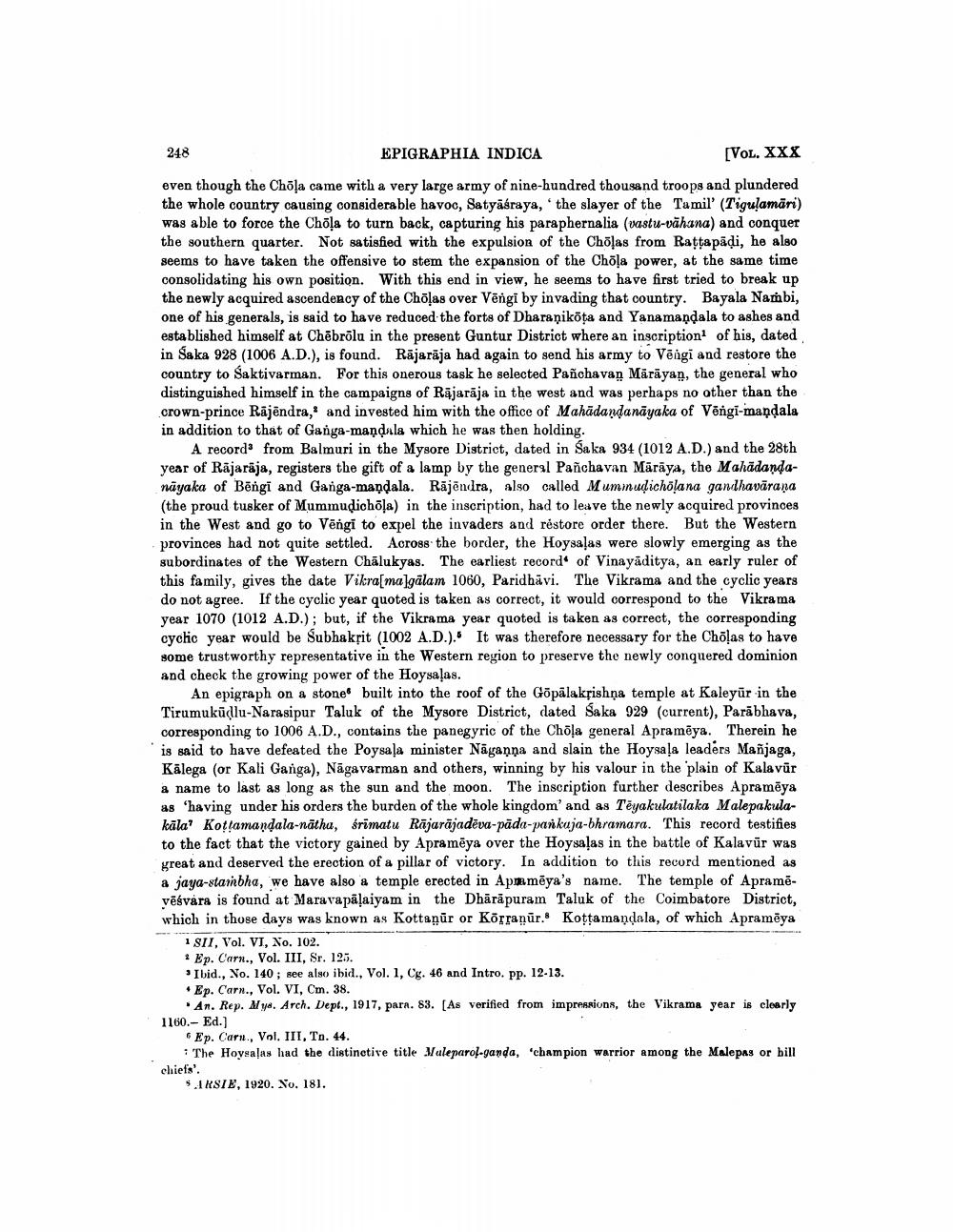________________
248 EPIGRAPHIA INDICA
[VOL. XXX even though the Chola came with a very large army of nine-hundred thousand troops and plundered the whole country causing considerable havoc, Satyasraya,' the slayer of the Tamil' (Tiguļamāri) was able to force the Chola to turn back, capturing his paraphernalia (vastu-vāhana) and conquer the southern quarter. Not satisfied with the expulsion of the Cholas from Rattapädi, he also seems to have taken the offensive to stem the expansion of the Chola power, at the same time consolidating his own position. With this end in view, he seems to have first tried to break up the newly acquired ascendency of the Chõļas over Vēngi by invading that country. Bayala Nambi, one of his generals, is said to have reduced the forts of Dharaņikota and Yana mandala to ashes and established himself at Chēbrölu in the present Guntur District where an inscription of his, dated in Saka 928 (1006 A.D.), is found. Rājarāja had again to send his army to Vēngi and restore the country to Saktivarman. For this onerous task he selected Panchavan Mārāyan, the general who distinguished himself in the campaigns of Rājarāja in the west and was perhaps no other than the crown-prince Rājēndra, and invested him with the office of Mahādandanāyaka of Vengi-mandala in addition to that of Ganga-mandala which he was then holding.
A record' from Balmuri in the Mysore District, dated in Saka 934 (1012 A.D.) and the 28th year of Rajaraja, registers the gift of a lamp by the general Panchavan Mārāya, the Mahādandanayaka of Bēngi and Ganga-mandala. Rājēndra, also called Mummudichõlana gandhavārana (the proud tusker of Mummudichōļa) in the inscription, had to leave the newly acquired provinces in the West and go to Vēngi to expel the invaders and restore order there. But the Western provinces had not quite settled. Across the border, the Hoysaļas were slowly emerging as the subordinates of the Western Chalukyas. The earliest record of Vinayāditya, an early ruler of this family, gives the date Vikra[ma]galam 1060, Paridhāvi. The Vikrama and the cyclic years do not agree. If the cyclic year quoted is taken as correct, it would correspond to the Vikrama year 1070 (1012 A.D.); but, if the Vikrama year quoted is taken as correct, the corresponding cychic year would be Subhakrit (1002 A.D.). It was therefore necessary for the Cholas to have some trustworthy representative in the Western region to preserve the newly conquered dominion and check the growing power of the Hoysalas.
An epigraph on a stones built into the roof of the Gopālakṣishņa temple at Kaleyür in the Tirumukūdlu-Narasipur Taluk of the Mysore District, dated Saka 929 (current), Parābhava, corresponding to 1006 A.D., contains the panegyric of the Chöļa general Apramēya. Therein he is said to have defeated the Poysala minister Nāgaņņa and slain the Hoysala leaders Mañjaga, Kälega (or Kali Ganga), Nägavarman and others, winning by his valour in the plain of Kalavür a name to last as long as the sun and the moon. The inscription further describes ApramĒya as 'having under his orders the burden of the whole kingdom' and as Téyakulatilaka Malepakulakāla? Kottamandala-nätha, srimatu Rājarājadēva-pāda-pankaja-bhramara. This record testifies to the fact that the victory gained by Apramēya over the Hoysaļas in the battle of Kalavūr was yreat and deserved the erection of a pillar of victory. In addition to this record mentioned as a jaya-starbha, we have also a temple erected in Apmımēya's name. The temple of Apramevēsvåra is found at Maravapāļaiyam in the Dhārāpuram Taluk of the Coimbatore District, which in those days was known as Kottapur or Kõrranür. Kottamandala, of which Apramēya
1 SI1, Vol. VI, No. 102. 2 Ep. Carn., Vol. III, Sr. 125.
Ibid., No. 140; see also ibid., Vol. 1, Cg. 46 and Intro. Pp. 12-13. • Ep. Carn., Vol. VI, Cm. 38.
. An. Rep. Mys. Arch. Dept., 1917, para. 83. [As verified from impressions, the Vikrama year is clearly 1160.- Ed.]
Ep. Carn., Vol. III, Tn. 44. : The Hoysalas had the distinctive title Waleparol-ganda, 'champion warrior among the Malepas or bill chiefs'.
$.INSIE, 1920. No. 181.




